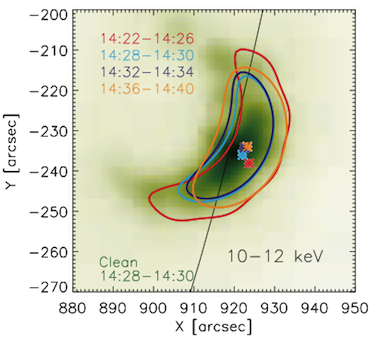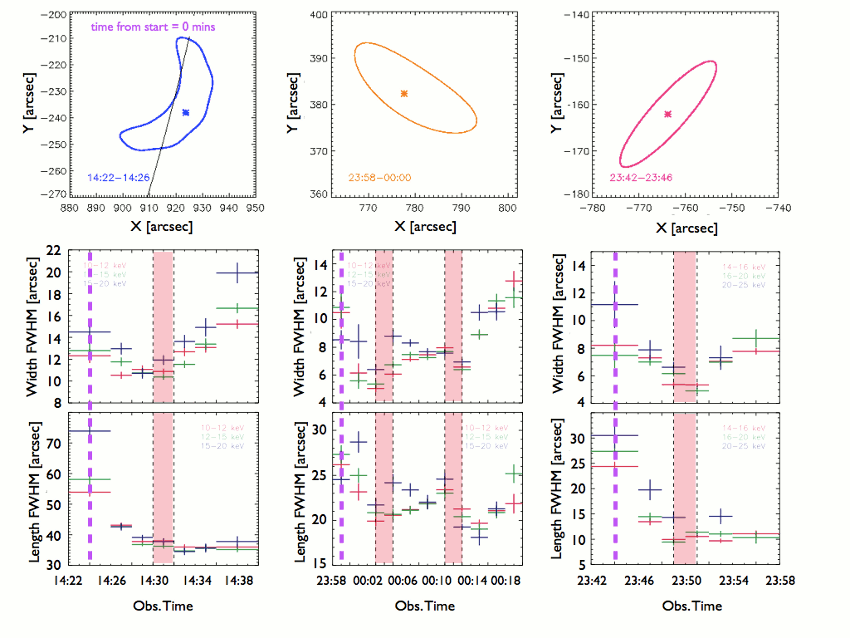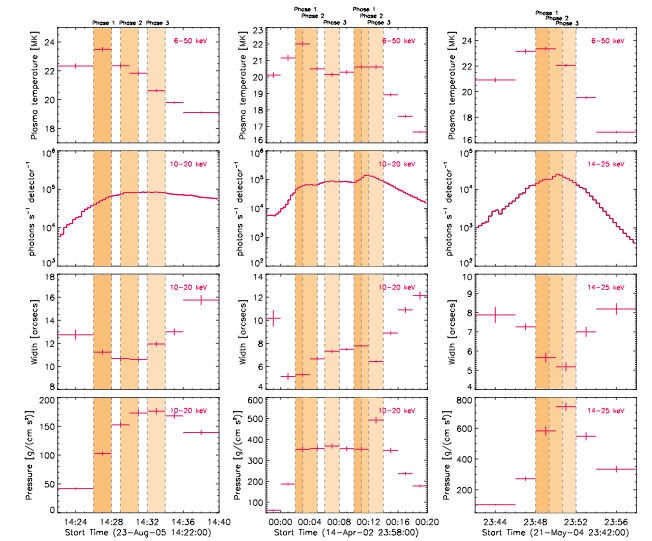Three-phase life leads to corpulent X-ray loops
| Nugget | |
|---|---|
| Number: | 198 |
| 1st Author: | Natasha Jeffrey |
| 2nd Author: | Eduard Kontar |
| Published: | April 15, 2013 |
| Next Nugget: | A huge gamma-ray burst |
| Previous Nugget: | Antipodal Flares |
Studying the spatial and temporal properties of X-ray loops

RHESSI has undoubtedly allowed us to resolve the angular structures of solar X-ray sources to a high degree. RHESSI cannot resolve individual loops but it does allow us to infer what the overall emitting X-ray region does, whether it consists of one or many loops. However, even during the RHESSI era, the spatial properties of coronal X-ray loops have not yet been explored extensively. The first real study of the spatial structures of loop-top X-ray sources occurred in 2008 with the finding that the X-ray loop lengths (the dimension parallel to the guiding magnetic field) increased with energy. This is opposite to the trend observed for hard X-ray footpoints, where the sizes appear to decrease with energy. Follow-up studies (Refs. [2], [3], [4]) were able to show that the widths (the dimension perpendicular to the guiding field) of the X-ray loops also increased with energy, an interesting discovery since electrons should not be able to move perpendicular to the field. Magnetic turbulence was suggested as one possible explanation for this interesting property.
These studies concentrated on the energetic changes of loops' spatial properties, and were obtained through the use of Visibility Forward Fitting (VIS FWDFIT) (Nugget 39). Unlike other imaging algorithms, VIS FWDFIT allows us to find relatively accurate position and size measurements from the moments of the X-ray visibilities by comparing them with a simple distribution such as an elliptical Gaussian, or in our case a curved elliptical Gaussian, which is basically a loop. Therefore, X-ray sources in the corona that appear as a singular, simple loop shape can be fitted in this way, giving us the loop length Full Width at Half Maximum (FWHM), loop width FWHM and the loop top position (with a little bit of work! - see Ref. [5]).
Using the VIS FWDFIT method, we decided to extend the investigation of loop spatial properties with a very simple study; observe for the first time how these X-ray loops changed with time during the X-ray rise, peak and decay phases of the flare. For this we managed to find three suitable events with a simple loop shape: 23rd August 2005 from 14:22, 14/15th April 2002 from 23:58 and 21st May 2004 from 23:42.

Three-phase X-ray time line
We found that all three X-ray loops exhibited similar and interesting temporal trends in both their observed spatial properties and inferred physical properties such as temperature, number density and thermal pressure. Peaks in X-ray emission denoted periods where there were changes in the loop spatial dynamics and interestingly of all, a study of temperature, volume, number density and thermal pressure showed how the X-ray loops went through three phases denoted by three clear peaks: the first in temperature, the second in X-ray emission and the third in thermal pressure. Each of these phases, for each flare, can be seen clearly in Figure 3. Before the peak in X-ray emission, both the loop length and corpulence fell, and after the peak the loop corpulence rose again while the loop length seemed to remain approximately constant - at least for two flares that only have one clear X-ray peak. The changing shapes (corpulence and length) can be seen for 23rd August 2005 event in Figure 1 and for all events in Figure 2. Loops start relatively long and thin and then become smaller before growing in corpulence at later stages. Figure 2 also shows the quantitative changes in lengths and widths of each loop.

Suggested explanation for our observations
Although we see the the volume of the loop decreasing before the peak in X-ray emission, the relationship between temperature and volume does not support simple compressive heating as in a collapsing magnetic trap model. The shrinking loop widths over time are much harder to explain than the decreasing loop lengths since electrons should be unable to move across the guiding field lines threading the corona. This leads to the suggestion that the field lines themselves are being squeezed together during this time.
Whatever the process causing the initial temperature increase and shrinking corpulence, we do believe that thermal conduction towards the lower corona and chromosphere are mainly responsible for phases two and three of the loops life. Thermal conduction causes chromospheric evaporation and this leads to increasing number density and thermal pressure in the loop. This would produce the decreasing loop lengths as electrons interact at shorter and shorter distances and the increasing thermal pressure in the region could probably balance the shrinking process. Increasing thermal pressure would eventually cause the increasing loop corpulence.
A far more detailed study of the three events can be found in Ref. [5].
References and links in the article
[3] Properties of the Acceleration Regions in Several Loop-structured Solar Flares
[4] Turbulent cross-field transport of non-thermal electrons in coronal loops: theory and observations
